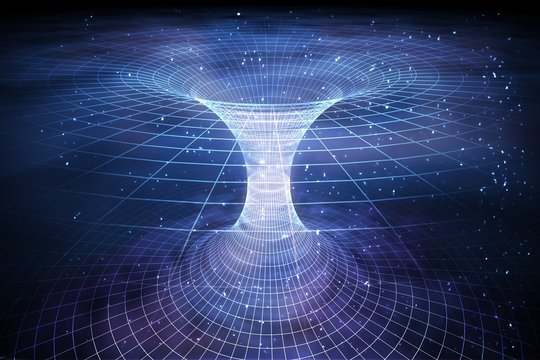The ability to move at the speed of light is one aspect of science that continues to elude researchers. This is mainly due to our lack of technological capabilities, as humans are incapable of currently creating something that can reach the desired speed. But what if we had the technology to reach the speed of light? What problems would arise, stopping us from travel at those speeds?

Light Itself
Light itself is already a very elusive concept, as it can both act as a particle and a wave, as proven by “The Double-Slit Experiment”. This experiment showed humanity that light is capable of acting differently based on whether it is being observed or not, fairly similar to the idea of Schrödinger’s Cat. Because of this, light has continued to puzzle scientists, leading to constant research to learn new things about one of the most vital aspects of our lives.
Perhaps one of the most interesting things about light is the idea of how it exists. Through many calculations, scientists have concluded that the speed at which we travel has a heavy impact on how our bodies and minds experience time. With this in mind, what would life be like through the eyes of light? In theory, anything traveling at the speed of light does not experience the flow of time, meaning that although light takes 8 minutes to get from the Sun to the Earth, the light itself would feel as though those 8 minutes were instant. If light were able to actually experience this, it would make sense for the light to experience its entire journey from the sun, as well as each point along the way, instantly and indefinitely; however, that is not the case. Rather, the concepts of time and distance become meaningless at the speed of light.
Traveling at the Speed of Light
Humanity has dreamed of being able to travel at the speed of light for centuries; however, the truth of the matter may be more disappointing than initially believed. As we apply the concepts of how light experiences its own travel, this point begins to become clearer to us. In reality, there is likely never going to be a man-made object that will be able to travel at the speed of light, and that is simply because physics limits us. Because photons have no mass, they aren’t limited by physics in the way that we are. Factoring in mass, scientists believe that it would require an exponential amount of energy to reach near the speed of light, requiring infinite energy to actually reach it. This is because, as an object with mass, traveling faster gives an object more relativistic mass, requiring the object to use more energy to speed up. As a result, travel at such speeds is impossible.
Hypothetically, if it were possible to travel at the speed of light, would it even be safe? Due to the increasing relativistic mass of the object, we can observe that even crashing into a grain of sand at such speeds could cause catastrophic damage, not just to a ship, but to entire planets as well. If a single grain of sand were able to reach the speed of light and crashed into the Earth, humanity would likely be wiped out on impact. The energy released from this impact could be equivalent to the energy released from a large asteroid impact, or even the energy released in a supernova. This impact would be far more devastating than any weapon humanity currently has the capability to wield, and will likely never be able to wield.

Faster Than Light (FTL)?
Faster Than Light, or better known as FTL, travel is truly impossible; however, let’s say it were possible. What would FTL travel be capable of doing for humankind? Any object traveling at FTL speeds would create a time paradox, as these objects would theoretically reach their destinations before leaving for them. That’s right. FTL travel, in theory at least, would create the ability to travel backwards in time, allowing us to change the past as we see fit. This creates a massive issue, as it implies that simply traveling at FTL speeds would create a paradox where the future could be consistently influencing the past, possibly even tearing apart the fabric of the Space-Time Continuum. If this were to happen, it is entirely possible that FTL travel could create events never before witnessed in the universe, creating unknown phenomena and forcing the universe into instability.
What Can We Do?
If we can’t travel at the speed of light or faster, then how should we direct our research to find different ways of travel? The most commonly accepted theory to travel faster than light is through the usage of wormholes. A wormhole theoretically bends space and time, allowing two points in the universe to be connected to one another, regardless of distance. The most common example used to show how a wormhole functions is by drawing two dots on a piece of paper. Normally, to get from one dot to the other, you have to draw a line; however, if you bend the paper, you can touch the two dots together and tear open a hole, connecting the two. While this bends spacetime, it theoretically should not break the laws of physics, and is therefore a possible solution.

The next most commonly accepted solution is through the use of a warp drive. Warp drives, conceptually, expand and contract spacetime outside of an object, essentially creating a bubble around it. This means that the object itself does not travel at or faster than the speed of light, but rather the warp drive contorts spacetime around it to accelerate the hypothetical bubble. Basically, this means that a ship would travel at its constant speed, and the warp drive would be interacting with spacetime, “pulling” itself forward by “moving” the universe backwards.
These two proposed theories are the most probable ways that humanity will travel through the universe in the future. There are many other theories that scientists have put forth as solutions to FTL travel; however, most of these theories are based around the usage of Tachyons, Quantum Entanglement, or Negative Energy; however, Tachyons and Negative Energy are still hypothetical and have yet to be observed within our universe, while Quantum Entanglement would only allow for extremely basic forms of communication rather than actual travel. Overall, humanity is far from reaching the ability to travel the universe, but as we continue to further our understanding of light and physics, we get closer and closer to finding a solution that we can bring forth into reality.




评论 (0)